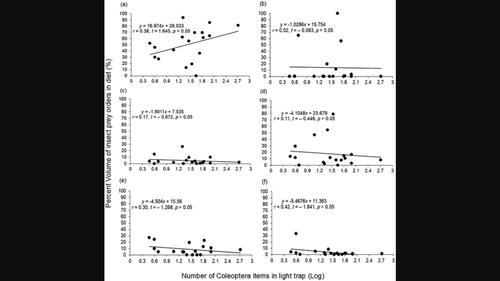当前位置:
X-MOL 学术
›
Ecol. Res.
›
论文详情
Our official English website, www.x-mol.net, welcomes your feedback! (Note: you will need to create a separate account there.)
Composition and temporal variation in the diet of intermediate horseshoe bat, Rhinolophus affinis, relative to insect abundance in a tropical rainforest environment of Southeast Asia
Ecological Research ( IF 2 ) Pub Date : 2023-05-15 , DOI: 10.1111/1440-1703.12398 Mansour Saad Abulqasim Mohamed 1, 2 , Shahrul Anuar Mohd Sah 1 , Nurul‐Ain Elias 1
Ecological Research ( IF 2 ) Pub Date : 2023-05-15 , DOI: 10.1111/1440-1703.12398 Mansour Saad Abulqasim Mohamed 1, 2 , Shahrul Anuar Mohd Sah 1 , Nurul‐Ain Elias 1
Affiliation

|
Dietary studies on insectivorous bat species in Southeast Asia are relatively few. We studied diet of the intermediate horseshoe bat, Rhinolophus affinis, and the temporal variations in prey resource use. We also measured prey availability in order to explore whether this species is a generalist or specialist feeder. A total of 665 fecal samples were collected from 133 captured individuals from January to December 2019 in a tropical rainforest of Penang Island (Malaysia). A descriptive analysis of samples revealed a total of eight insect prey orders. The main taxon was Coleoptera (Percent Volume >50%), followed by Isoptera, Hemiptera, Lepidoptera, Hymenoptera and Diptera, respectively (5–15%). Neuroptera and Psocoptera were occasionally found in the samples (each <1%). This result exhibits a degree of dietary specialization on coleopterans although the diet composition was flexible and significantly varied over time (among months and within nights). Based on light trapping, Coleoptera, Hemiptera, Lepidoptera, Hymenoptera and Diptera were frequent insects in the study area, while Isoptera was seasonally abundant. The correlation between variation in the diet and light trap for each prey taxon was mostly not statistically significant, suggesting that R. affinis do not consume prey in proportion to abundance and alternatively may discriminate between prey items when foraging and take prey in rank order. Given this, we further investigated the heavy consumption of absolute abundance of Coleoptera (high-ranking prey in diet). As a result, coleopterans were included in the diet regardless of the abundance of other prey showing a pattern of dietary specialization.
中文翻译:

东南亚热带雨林环境中中型马蹄蝠(Rhinolophus affinis)饮食的组成和时间变化与昆虫丰度的关系
对东南亚食虫蝙蝠物种的饮食研究相对较少。我们研究了中级马蹄蝠(Rhinolophus affinis)的饮食,以及猎物资源利用的时间变化。我们还测量了猎物的可用性,以探讨该物种是通才还是专业捕食者。2019 年 1 月至 12 月,从马来西亚槟城岛热带雨林中捕获的 133 名个体中,总共收集了 665 份粪便样本。对样本的描述性分析揭示了总共八种昆虫猎物目。主要分类单元是鞘翅目(体积百分比>50%),其次是等翅目、半翅目、鳞翅目、膜翅目和双翅目(5-15%)。样本中偶尔发现神经翅目和裸翅目(各<1%)。这一结果显示了鞘翅目动物的饮食有一定程度的专业化,尽管饮食成分很灵活,并且随着时间的推移(几个月和夜间)发生显着变化。基于光捕获,鞘翅目,半翅目、鳞翅目、膜翅目和双翅目昆虫是研究区的常见昆虫,而等翅目昆虫则季节性丰富。每个猎物分类群的饮食变化和光陷阱之间的相关性大多不具有统计显着性,这表明R. affinis不会按照猎物数量的多少来消耗猎物,并且在觅食时可能会区分猎物并按等级顺序捕获猎物。鉴于此,我们进一步调查了鞘翅目(饮食中的高级猎物)绝对丰度的大量消耗。结果,无论其他猎物是否丰富,表现出饮食专门化模式,鞘翅目动物都被纳入饮食中。
更新日期:2023-05-15
中文翻译:

东南亚热带雨林环境中中型马蹄蝠(Rhinolophus affinis)饮食的组成和时间变化与昆虫丰度的关系
对东南亚食虫蝙蝠物种的饮食研究相对较少。我们研究了中级马蹄蝠(Rhinolophus affinis)的饮食,以及猎物资源利用的时间变化。我们还测量了猎物的可用性,以探讨该物种是通才还是专业捕食者。2019 年 1 月至 12 月,从马来西亚槟城岛热带雨林中捕获的 133 名个体中,总共收集了 665 份粪便样本。对样本的描述性分析揭示了总共八种昆虫猎物目。主要分类单元是鞘翅目(体积百分比>50%),其次是等翅目、半翅目、鳞翅目、膜翅目和双翅目(5-15%)。样本中偶尔发现神经翅目和裸翅目(各<1%)。这一结果显示了鞘翅目动物的饮食有一定程度的专业化,尽管饮食成分很灵活,并且随着时间的推移(几个月和夜间)发生显着变化。基于光捕获,鞘翅目,半翅目、鳞翅目、膜翅目和双翅目昆虫是研究区的常见昆虫,而等翅目昆虫则季节性丰富。每个猎物分类群的饮食变化和光陷阱之间的相关性大多不具有统计显着性,这表明R. affinis不会按照猎物数量的多少来消耗猎物,并且在觅食时可能会区分猎物并按等级顺序捕获猎物。鉴于此,我们进一步调查了鞘翅目(饮食中的高级猎物)绝对丰度的大量消耗。结果,无论其他猎物是否丰富,表现出饮食专门化模式,鞘翅目动物都被纳入饮食中。



























 京公网安备 11010802027423号
京公网安备 11010802027423号